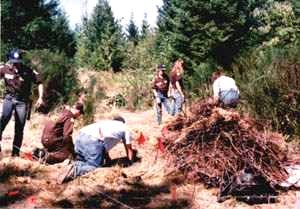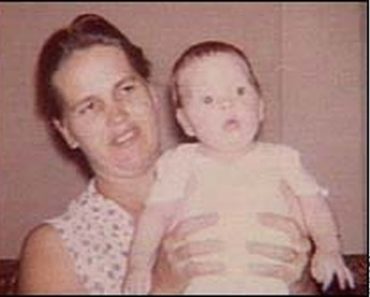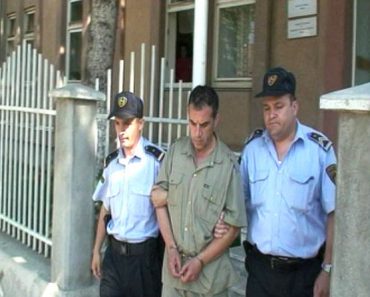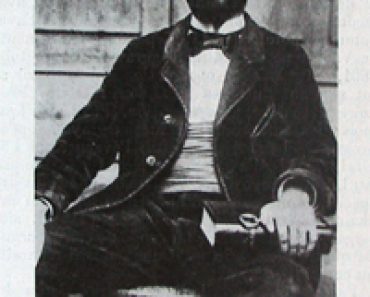Dayton Leroy Rogers | Serial Killer

Dayton Leroy Rogers
Born: 09-30-1953
Molalla Forest Murderer
American Serial Killer
Crime Spree: 1983–1987
Incarcerated at the Oregon State Penitentiary
As Oregon lawmen drew a bead on this violent wacko, they found out that he preferred prostitutes as his prey, had an appetite for kinky sex, and liked to start things rolling with vodka and orange juice. During the course of their investigation they also learned that he was Oregon’s worst serial killer to date, a murderer whose blood lust knew no bounds. And so the unraveling of Dayton Leroy Rogers began.
Tuesday, July 7, 1987, was another hot, sultry summer day in Oregon. Heather Brown, 31, a prostitute, had worked the night before in her area along Portland’s Union Avenue, a high-crime area dominated by prostitutes, pimps, and drug dealers. Several other hookers had been in place that night, but despite the others, Heather, dressed in a skintight outfit that left nothing to the imagination, never had to wait long for a customer to come along. It had been a busy night for her, and as a result she had slept in until nearly noon.
When she climbed out of bed, she reached for her pack of cigarettes but found that it was empty. Needing a smoke, she left her two small children with her roommate and began walking toward a nearby 7-Eleven store, again dressed in the skintight outfit that she had worn the night before. About halfway to the store, a man in a blue Nissan pickup stopped and offered her a ride. Figuring that she could make a few quick bucks, Heather accepted and climbed inside. The driver headed out of the city toward a wooded area known as the Molalla Forest.
The One That Got Away
The “john” introduced himself as Steve, and explained that he was a professional gambler from Nevada. They drove along for some time, and at one point stopped at a convenience store so that Heather could buy a pack of cigarettes and a Coke and so that “Steve” could purchase a six-pack of beer. Afterward they continued driving until they reached the wooded area, when their conversation turned to business. He said that he was going to drive into the hills, and that he wanted to “tie someone up and fuck them.” He moved to touch her thigh, but she pushed his hand away and demanded that he take her back to Portland. However, he refused and turned off onto an unpaved logging road where he sped up to about forty miles per hour.
Heather grabbed her shoes off of the floor, ready to make a break for it when the time was right. But the ‘john’ caught her eyeing the door handle, and he reacted instantly. He swerved the pickup recklessly, so she would lose her sense of balance, and reached toward her, placing his hand over her chest to prevent her from jumping out of the truck. He then stepped on the accelerator and was soon speeding to more than sixty miles per hour. Nearly out of her mind with fear, Heather struggled violently and managed to break free of the man’s hold. In one swift move she opened the door and jumped from the speeding truck. The ‘john’ slowed his vehicle a little but, apparently aware that a log truck was close behind, kept on going.
A Killer On The Loose

When the logger rounded the curve, he saw Heather lying in the road and slammed on his brakes. Seeing that she was injured, and grateful that he hadn’t hit her, he helped her into the cab of his rig. One of her eyes was bleeding, which he helped her to cover, and she had other scrapes and cuts. She told the logger that she had to jump out of the man’s pickup because she feared that he was planning to kill her. Since she was obviously very shaken up, the logger didn’t probe her with questions. Instead, he arranged to have her driven to a medical clinic in Molalla, where it was determined that she had suffered a concussion and multiple abrasions to her left temple area, right forearm, and hand.
The matter was reported to the Clackamas County Sheriff’s Department and was written up as case number 87-20998. The incident report would become the first clue of the horror that was already well underway to veteran Detective John Turner, 44, a distinguished-looking man of Anglo-Saxon descent.
Turner had no way of knowing it yet, but the evil outrage that was taking its toll on Portland’s streetwalkers would virtually consume his life for much of the next two years and would eventually lead him to the most vicious and remorseless killer with whom he had ever dealt or would likely ever face again.
Steve the Gambler
It has been said that blood lust is an aberration unique to the human animal, that when it occurs, it does so without purpose and has no reverence for the normal needs intrinsic to humankind survival. The aberration–for that is what it really is–is clearly sexual violence and all evil, and it rears its diabolic head when its host fails to achieve sexual gratification in any other way. As a result, many–particularly women and children–who unwittingly come into contact with such an individual, die needlessly and without mercy at his hands.

Dayton Leroy Rogers, 33-years-old when his blood lust neared its peak, was fearfully known to many of Portland, Oregon’s prostitutes as “Steve the Gambler” and has been afflicted by blood-lust since his late teens, perhaps longer. It usually materialized in the form of a headache, inflicting on him a splitting, blinding white pain, and perhaps he was always subconsciously aware that only the sight of another’s pain, the sounds of her anguish, or, ultimately, the spilling of her blood would relieve his own suffering. When the headaches began, the only way to make them go away was to let his dark side fully emerge.
Dayton Leroy Rogers seemed personable enough on the surface, as long as he wasn’t in the midst of one of his mood swings. He was well known in the small communities of Woodburn and Canby, and people seemed to like him. A mechanic by trade, a skill he had learned in prison, Dayton ran a small successful engine repair business, was married, and had an eighteen-month-old boy who was a mirror image of him. Few people saw the evil that lay beneath the thin veneer, and many of those who were unlucky enough to witness his dark side firsthand did not live to talk about it.
Dayton Leroy Rogers Goes On The Prowl
Dayton’s headaches seemed to worsen during the summer of 1987 and for that reason he was away from home much of the time. He claimed that he was working at his shop during his absences, which ranged from a few hours to all night, and his wife, Sherry, saw little reason, at first, to doubt him. When she would call to check up on him in the early evening, he usually answered the telephone.
On the occasions that he didn’t, he always had an excuse. He would explain that he had been in the middle of a project and hadn’t wanted to leave it to pick up the phone. Or, more commonly, he would tell Sherry that he had gone out to get coffee, perhaps a bite to eat, anything that would convince her he was only taking a break to get away from the shop for a while. Often, however, he waited until it was very late, until he was certain that Sherry was in bed and fast asleep, before beginning the prowl.
Soon his working late became routine, a way of life, and Sherry’s phone calls became less frequent. Although she began to hear stories about him frequenting the local taverns and bars, she tried very hard to maintain the faith she had always had in him. She might have become suspicious of his activities sooner if only she had taken the trouble to check the mileage on his pickup. But she hadn’t, and he put more miles on the truck in a single week than most people drive in a month.
August 6th
August 6th started out for the Rogers family like most other days. Dayton Leroy Rogers got up early, showered and shaved, had a light breakfast, and drove to his small engine repair shop in Woodburn before 8 a.m. Outwardly, he seemed happy. Business had picked up during the summer to the point where he had to hire a man to help him, and several new repair orders were coming in every day.
Soon, however, he began to feel the pressures of the backlog despite the new help, and his headaches became more frequent, as did his nocturnal outings. At times Sherry found herself wondering what had come over him, seeing him sitting quietly and staring into space, but she never said anything. Even though she had heard rumors about him carousing the nightspots and secretly feared that he may have been seeing other women, she somehow convinced herself that the pressures from his business had become too great, and she didn’t want to do or say anything that might add to his troubles.
The Pounding Was More Than He Could Bear
It wasn’t until later that afternoon that the pounding inside Dayton’s head became more than he could bear. He had to do something to stop the headache. He left his assistant in charge of the shop and drove to the liquor store at the North Park Plaza in Woodburn. There he purchased a ten-pack of Smirnoff vodka miniatures to replace the depleted stock he normally kept behind the seat of his pickup. He also purchased a couple of bottles of orange juice, the type in the disposable plastic bottles that he liked so well. He drank one of his crudely mixed screwdrivers quickly, and the headache subsided a little.
Afterward, Dayton Leroy Rogers returned to his shop and waited, thinking and planning the rest of the evening. He needed something more effective than the alcohol for his headache. The remedies were there, he knew, out in numbers on Portland’s streets, his for the asking and a $50 bill. It had all been so easy with all of the others that there was no stopping him now.
At 8:30 p.m. Dayton Leroy Rogers drove home, where he had dinner with Sherry and his son. He explained that he had to return to the shop and work very late, perhaps into the early morning hours, to catch up on some of the overdue work. Sherry, an attractive curly-haired silver brunette at five feet four inches tall, 120 pounds, and three years younger than Dayton, didn’t protest. She never did. Devoutly religious and somewhat naive, she always trusted her husband and rarely questioned his activities.
Half an hour later Dayton Leroy Rogers was gone. He stopped off at his shop, had a couple more drinks, and tinkered with some of the easier repair projects to kill time. Shortly after midnight he changed into his stepping-out clothes, that he kept inside his special closet, and waited a little longer until he was certain that Sherry had gone to bed. By 12:30 a.m. he was heading toward Portland.
The One That Didn’t Get Away
On August 7, 1987, by 1:00 a.m., the man who called himself “Steve the Gambler” was back on Union Avenue, which was known as Portland’s “Prostitute Row,” looking for some kinky action.
After a short cruise, he stopped a blonde near the corner of Northeast Union Avenue and Wygant Street. He recognized her as a hooker he’d picked up before during Portland’s 1987 Rose Festival. She was a somewhat large woman but, from a distance, appeared attractive. She knew how to dress and held her weight well. He pulled over and invited her inside. Recognizing him as a former customer, the woman didn’t hesitate.
No one, except for the john, knows the precise details of what happened between the couple from 1 to 3:00 a.m. But at some time prior to 3:00 a.m., they pulled into the parking lot of a Denny’s restaurant on the 16200 block of Southeast McLoughlin Boulevard in Oak Grove, a Clackamas County suburb of Portland. With the taverns and bars having just closed, business was brisk there. It was the only restaurant open in the area at that time of the morning.
Michael Fielding, 32, who lived in an apartment nearby, had gone to bed a couple of hours earlier and was sleeping soundly when he suddenly heard the muffled screams of a woman in intense pain.
“Help me!” screamed the woman. “Please help me! Rape! I’m being raped!” As Fielding climbed out of bed and headed for the window that overlooked the parking lot, the screams became louder, no longer muffled. He arrived at the window in time to see a man run beneath a streetlight.
Shadows In The Night
Moments earlier, James Dahlke, 50, had just arrived at Denny’s. He was alone as he parked his 1983 Ford van and started walking toward the restaurant. He heard a woman yelling and screaming, but couldn’t quite make out what she was saying. But he could see two human forms in the parking lot in the direction from which the screams had come. Although it was dark, he could see two people, a man and a woman, who appeared to be struggling with each other. After his eyes adjusted to the darkness of the parking lot, Dahlke could not believe what he saw. There, near the middle of the parking lot, lay a completely naked woman! A man was kneeling over her, but Dahlke could not immediately determine why.
Charles Gates, a handicapped customer, had just arrived and had barely situated himself in his wheelchair when he heard the screams. Already outside in the parking lot, he was on his way over to the woman, as was Dahlke. When the man kneeling over the woman saw Dahlke and Gates approaching, he jumped to his feet and ran in the opposite direction. Gates reached the woman first.
“My God! He slit her throat!” exclaimed Gates, falling from his wheelchair. Experienced in first aid and emergency medical treatment, Gates noted that the woman was not breathing and would not respond to questions. Finding no carotid pulse and undaunted by all of the blood, he immediately began CPR and mouth-to-mouth resuscitation.
The Crowd Gathered
As a crowd gathered, Dahlke instructed restaurant personnel to call for medical and police help. Then he returned to the parking lot only to discover that Gates’s gallant attempts had not revived the woman. Dahlke could see why. The woman was covered with blood and stab wounds.
A couple of minutes later, Dahlke again spotted the man he’d seen only moments before kneeling by the nude victim. The man was coming around the side of a building adjacent to the restaurant and was headed for a small foreign pickup parked nearby.
“That’s him!” Someone shouted. “That’s the son-of-a-motherfucker!”
By that time two other bystanders, Stan Conner and Richard Bergio, had rushed over to see what was happening. After learning of the incident, Conner and Bergio ran for their own vehicles. They attempted to block off the exits from the parking lot with their cars, but the man with the pickup drove out over the sidewalk.
Bergio, determined not to let the guy get away, sped out of the parking lot in his own car in hot pursuit of the pickup, which was by now heading south on McLoughlin Boulevard toward Gladstone. Bergio chased the pickup through Oak Grove and into nearby Gladstone, at times at speeds over 100 miles an hour. Then, Bergio got close enough to the pickup to copy down its license plate number. Satisfied that he’d done all that he could, Bergio gave up the chase and returned to the crime scene, where he now found a team of Clackamas County sheriff’s deputies and a rescue team from the Oak Lodge Fire Department.
She Could Not Be Saved
The rescuers valiantly tried to revive the woman, but to no avail. A short time later, she was loaded onto an ambulance and taken to Emanuel Hospital and Health Center in Portland, where she was pronounced dead on arrival.
Meanwhile, several deputies rounded up witnesses and took a statement from each.
Six of those interviewed said they’d heard the woman’s screams for at least two minutes before her body was found. One of the witnesses, Michael Fielding, told the deputies how the woman’s screams had awakened him.
It had sounded as though her screams had come from inside a closed vehicle, through the glass, at first, said Fielding, because her shrieks were muffled. She was obviously in intense pain and had cried out that she was being raped. When Fielding got to the window, though, all he saw was the man who ran beneath the streetlight.
“It was like a spotlight,” said Fielding. “If he hadn’t run underneath it, I wouldn’t have seen anything.” He told the deputies that he had gotten a good look at the man, and that he could likely recognize him if he saw him again.
Deputies found several articles of clothing not far from where the victim’s body had lain. The clothing, believed to be hers, included blue jeans, a hooded blue sweatshirt with white trim, and a single tennis shoe. But, the deputies wondered, where was the other shoe?
The Plates Lead To Dayton Leroy Rogers
No identification, either in the clothing or on the parking lot, was found. But after additional searching, the deputies found a double-length pair of shoelaces, tied together with loops at both ends, prompting some to speculate that the woman had been hogtied at one point.
A short time later, Clackamas County Sheriff’s Detectives John T. Turner and Mike Machado arrived at the crime scene. After being briefed on that morning’s events, Turner took the license plate number (Oregon CYW 194) provided by Richard Bergio and ran it through the Oregon State Department of Motor Vehicles computer. Moments later, Turner learned that the pickup’s registered owner was 33-year-old Dayton Leroy Rogers, whose address was listed as being in the 10500 block of South Heinz Road in Canby, Oregon, about 20 miles south of the crime scene.
Turner and a team of deputies reached Rogers’ home at approximately 5:00 a.m. They saw no sign of the pickup on the property, and they were subsequently told by a relative that Rogers was not at home but could likely be found at his auto-repair shop in the 11600 block of Pacific Court in Woodburn, a few miles south of Canby. The relative told the sleuths that Rogers sometimes worked odd hours at the shop.
 The Authorities Are Invited In
The Authorities Are Invited In
It was 5:35 a.m. when Detective Turner arrived at Rogers’ shop. After a cursory glance around outside, he knocked on the door of the shop until a man with bloodshot eyes answered. Smelling of alcohol, the man identified himself as Dayton Leroy Rogers. After Turner told Rogers that he and the deputies were there as part of a homicide investigation, Rogers allowed them inside.
Although Detective Turner noted that Rogers’ pupils were dilated, he observed that the man had no difficulty walking and that his speech was not slurred, prompting him to conclude that Rogers had been drinking but was not drunk. When asked, Rogers told the detective that he’d been at the shop all night and had been drinking bourbon and strawberry mixer.
“Mind if I take a look around?” asked Turner.
“Go ahead and search the place,” said Rogers. “Search the truck, too, if you want to.”
Rogers told the detective that his pickup had been at the shop all night. Turner shot him a dubious glance, walked over to the truck and raised the hood.
The Authorities Started Asking Questions
“Been here all night, huh?” asked Turner, as he attempted to place his hand on the engine’s valve cover, which was too hot to touch. “You haven’t gone out at all, have you?”
Rogers, or somebody, had recently run the engine hard, thought Turner, as he pulled his hand away from the hot engine.
“What happened to your hand?” asked Turner, observing that Rogers’ right hand was bandaged. “Cut yourself?”
Rogers explained that he’d been using a hacksaw a few hours earlier, when it suddenly slipped and cut his hand. Turner asked if he had left the shop for first aid; Rogers responded that he’d gone to Willamette Falls Hospital in Oregon City that same morning to have the wound treated.
So he had left the shop, reflected Turner, who also wondered why the man had initially lied about it. If he didn’t have anything to hide, why was he acting so suspiciously?
Dayton Leroy Rogers Was Arrested
There was no doubt that Rogers’ pickup was the one seen fleeing the scene of the crime. It matched in appearance and the license plate identification was the same. Because of that and his suspicious demeanor, Rogers was arrested a few minutes later and taken to the Clackamas County Jail in Oregon City, where he was held on suspicion of murder.
Meanwhile, the detectives identified the dead woman as 25-year-old Jennifer Lisa Smith, mother of two. Her last known address was in the 4800 block of North Albina Avenue in Portland, not far from Union Avenue. Additional background on Smith revealed that she had an arrest record for prostitution and indecent exposure.
Background on Dayton Leroy Rogers revealed that he was no stranger to law enforcement, either. In 1972, when he was 18, Rogers picked up a 15-year-old girl who had been hitchhiking in Eugene, Oregon. He had convinced her to go to a remote area to have sex with him, detectives learned. Risking a charge of statutory rape, Rogers picked the girl up again a few days later and they went together to a park to gather wood to make whistles for neighborhood kids. But he took her into a wooded area to again have sex with her.
After lying down on the ground, Rogers leaned over as if to kiss the girl. Instead, according to police reports, he stabbed her in the abdomen with a hunting knife. After pulling the knife from her stomach, the girl, bleeding profusely and in intense pain, convinced Rogers to take her to a hospital for treatment. She survived and later told authorities about the attack. On February 13, 1973, Rogers pleaded guilty to second-degree assault and was placed on four years’ probation for that attack.
The Second Attack
Less than six months later, the detectives learned, Dayton Leroy Rogers assaulted two 15-year-old girls with a soft-drink bottle. Although charged with one count each of second- and third-degree assault, Rogers was found not guilty by reason of mental disease or defect, Oregon’s equivalent to an insanity plea. He was sent to the Oregon State Hospital by Lane County Circuit Court Judge Helen Frye. He was released from the hospital on December 12, 1974.
These incidents prompted Darryl L. Larson, Lane County Deputy District Attorney, to write an after-sentence report on Rogers: “This man is an extreme danger to the community, particularly to young women. He is both sexually and physically violent and, without question, is a murder case looking for a place to happen.”
In January 1976, Rogers was indicted on a charge of first-degree rape in Clackamas County, but he was eventually acquitted of the charge. In February 1976, however, while the Clackamas County rape charge was still pending, Rogers picked up two Keizer, Oregon high school girls and, at knife point, allegedly raped one and threatened to rape the other.
According to John L. Collins, Yamhill County District Attorney, the two girls had skipped school and were walking down a Keizer street when Rogers saw them and convinced them to go with him.
All Just A Game
“He was a good talker and his method at the time was to pick up girls, particularly blonde girls,” said Collins. “They got into the car with him, and they went to get some beer.” After drinking beer and smoking marijuana together, said Collins, Rogers took a paring knife from the glove box of the car he was driving and threatened the girls with it. He used coat-hanger wire to bind the girls’ wrists and ankles.
“Afterward he apologized and pretended like it was all some kind of game,” said Collins. Dayton Leroy Rogers was nonetheless indicted on charges of rape and coercion. He pleaded not guilty by reason of mental disease or defect. Rogers was convicted only on the coercion charge and received a maximum five-year prison sentence.
“This was in a less-enlightened time,” said Collins, “when juries often felt that if the woman or girl contributed to the rape in any way, they would not convict him. In this case, I think it was because they drank beer and smoked marijuana with him.”
As the detectives probed deeper into Rogers’ background, they learned that he had been in and out of jail for a variety of reasons, including parole and probation violations and for kidnapping a local prostitute. All in all, the detectives learned, Dayton Leroy Rogers spent 27 months in Oregon prisons. His parole was formally terminated in January 1983.
The Evidence
Meanwhile, acting on a tip from one of Rogers’ relatives, investigators returned to the suspect’s Woodburn auto-repair shop, where they sifted ashes from a wood stove in Rogers’ office. There they found what appeared to be remnants of a burned tennis shoe. Analysis later determined that metal parts found in the wood stove closely matched the metal parts of the shoe that was discovered in the parking lot where Jennifer Smith was murdered. They also found pieces of colored glass, rhinestones, and star-shaped grommets inside the stove, their sources unknown.
Rogers’ truck had been impounded shortly after his arrest, after warrants had been obtained, and it was carefully searched for evidence. According to criminologists, there was blood inside the cab of the pickup, numerous knife cuts on the dashboard, upholstery, ceiling, and passenger door. They also found a single fingerprint matching that of Jennifer Smith’s right ring finger on the outside handle of the passenger door. The examination and search also turned up a small green band in the bed of the pickup; they later determined it had come from a small container of ready-to-drink orange juice.
Next, in their efforts to build a stronger case against Rogers, the detectives went to Willamette Falls Hospital in Oregon City to see how much of the suspect’s story about his wounded hand was true. After questioning the emergency room doctor who had attended to the wounds, the detectives learned that the cuts were not jagged as they would have been if a hacksaw blade had made them. They had been smooth and clean, more like wounds that would have been caused by a knife blade.
Dayton Leroy Rogers Is Identified
Although gut feelings told the investigators that Rogers was their man, they nonetheless assembled a photo lay-down, a group of six photographs of men, including Dayton Leroy Rogers, who had similar appearances. They displayed the lay-down to eyewitness Michael Fielding. It took him less than 20 seconds to identify Dayton Leroy Rogers as the man he saw stop briefly under a streetlight as he fled the Denny’s restaurant parking lot.
Because Jennifer Smith was a known prostitute and because of Rogers’ continued interest in hookers, detectives hit Portland’s streets and interviewed as many hookers as they could, focusing their attention on those who knew Jennifer. Not surprisingly, the detectives found several who knew Rogers, too.
Many of the hookers that the detectives talked to identified Rogers from a photo lay-down; several said he’d told them his name was Steve. One of the women even told investigators that she saw Jennifer Smith walk toward his pickup, as if to get inside, three hours before she was found murdered.
Dayton Leroy Rogers – Steve the Gambler
The detectives learned that he nearly always told the girls he was a professional gambler, usually saying that he was from Las Vegas but sometimes saying that he was from Reno, and that he typically offered $40 to $80 for a sexual scenario that involved bondage. He always had the girls completely undress, after which he bound their hands and feet at the wrists and ankles with rope, dog collars, wire, nylon stockings, shoe laces, and the like–anything that would hold their arms and feet securely in place. But many said that Rogers went far beyond bondage, subjecting them to intense physical pain, torture, even mutilation.
One prostitute told the detectives that Rogers had a foot fetish and found women’s arches sexually arousing. An interesting point, the detectives noted, considering that Jennifer Smith was barefoot when her body was found. Other prostitutes said that all of the “dates” occurred in the cab of Rogers’ pickup, and Rogers usually began by drinking vodka and orange juice. He usually stopped at a convenience store, said the hookers, where he bought ready-to-drink juice in small plastic containers.
One of the prostitutes accompanied a detective to a convenience store and picked out the brand of orange juice Rogers usually bought, in small plastic containers with green plastic caps security-sealed with green bands, just like the one found in the bed of Rogers’ pickup. He usually bought the vodka in the individual serving, one-and-a-half-ounce bottles, like those served by airlines.
The Hookers Just Kept Talking
One hooker told the detectives that Rogers picked her up and agreed to pay her $50 for straight sex. Instead, he tied her hands and feet and tortured her for hours by biting her on the breasts, buttocks, and feet, hard enough to draw blood. Another prostitute said she was subjected to the same type of treatment, except that he threatened to cut off her breasts with a knife. Yet another hooker told the detectives that Rogers cut off her clothes with a machete, and another said he cut the heel of her foot with a carving knife. One of the women said that he had subjected her to so much pain during a six-hour ordeal that she’d asked him to kill her. All of the women said that Rogers liked to masturbate during the encounters.
From the definitive autopsy of Jennifer Smith’s body, Dr. Karen Gunson, Deputy State Medical Examiner, determined that there were at least 11 knife wounds to the victim’s body, 10 of which were very deep. The medical examiner said that there were eight stab wounds to the front of Jennifer’s body, one of which severed a major artery on the left side of her chest and was likely the cause of death.
Jennifer also sustained slashing wounds to both of her breasts, two deep stab wounds to her abdomen that pierced her stomach, and a V-shaped stab wound in her back that pierced her liver. Dr. Gunson explained that the V-shaped wound might have been caused by two stabs that had overlapped.
The Victim Fought For Her Life
The victim also had slash wounds to both of her hands that cut all the way to the bone, wounds which Dr. Gunson described as defensive injuries caused when the victim tried to grab the knife blade from her attacker or otherwise tried to prevent him from stabbing her. Jennifer’s throat had also been slit.
“There were other wounds,” said Dr. Gunson, including two quarter-inch-wide bruises around both wrists. These bruises indicated that Jennifer had been tied up, perhaps with the shoelaces found at the crime scene. Gunson said that “a significant amount of pressure” must have been applied to Jennifer’s wrists for such bruising to occur.
After the investigators presented their case to a Clackamas County grand jury, Dayton Leroy Rogers was indicted on a charge of aggravated murder in the death of Jennifer Smith. The indictment alleged that Rogers murdered Smith during the course of rape, kidnapping, sexual abuse, and torture. It also alleged that Rogers killed Smith to cover up the other crimes.
Rogers retained Attorney Arthur B. Knauss of Oregon City to represent him, and he pleaded innocent to the charges. He was held without bail.

The Molalla Forest
In the meantime, on Monday, August 31st, Everett Banyard, 46, a crossbow hunter in pursuit of prey on a private 90,000-acre timber farm southeast of Molalla, Oregon, nearly stumbled over the nude, partly buried body of a young woman. The body, in an advanced state of decomposition, was partially covered with brush. Unnerved by his gruesome discovery, the hunter left the forest as quickly as possible and reported his find to the Clackamas County authorities.
When investigators arrived at the remote site–a recreation area near the Molalla River that is popular with fishermen, swimmers, hunters, hikers, and other outdoors types–the bow hunter led them up an old dirt logging road through the rugged mountain forest, mixed with evergreens and deciduous trees, to a nearly vertical slope where he’d discovered the body. Even though it was a little difficult to get to, the investigators had no trouble finding the corpse.
At first glance, the detectives couldn’t tell if the body had been buried by the forces of nature or if someone had attempted to conceal it. But one thing was certain–she was a murder victim.
Due to the lateness of the hour, no attempt was made to search the crime scene that evening. Instead, deputies were posted nearby as sentries to protect the scene until criminologists arrived the next morning.
More Bodies Found
Shortly after a search for evidence began the next day, searchers found two more corpses within 50 feet of each other, in the same general area as the first. The scene appeared to be a “cluster dump” similar to those used by the Green River serial killer in Washington State. Unsure of what they were dealing with here, the investigators temporarily halted the search while Colt, the Clackamas County Sheriff’s Department’s tracking dog, was brought in to assist in the search for more bodies.
Over the next five days, a total of seven female corpses were brought down from the forest ridge. All were nude when found, and all bore signs of stabbing, torture, and mutilation. Some of the victims’ feet had been crudely removed at the ankle with what appeared to be a blade with a serrated edge, like that of a hacksaw. One victim’s foot had been cut approximately two-thirds of the way through the bone, with the remainder broken off.
This prompted the detectives to consider that the perpetrator had sawed these women’s feet off while they were still alive and conscious in an attempt to elicit additional pain and suffering—however, the one victim whose bone had only been partially sawed through and then broken the rest of the way likely had gone into shock, and the breaking of the bone had likely been a last-ditch attempt at breaking through the shock barrier to elicit one final response to pain. Each of the victims were in varying degrees of decomposition, but two were markedly more advanced, having been there considerably longer than the others.
Striking Similarities
Despite the striking similarities between the female victims on the Molalla forest slope and Jennifer Smith—nudity, signs of stabbing, torture, mutilation—the detectives didn’t, at least at first, focus on Dayton Leroy Rogers as a possible suspect. He was in jail, charged with a different murder. However, as Detective Turner walked around the forest site he soon spotted miniature vodka bottles, an old package that they had been purchased in, and disposable orange juice bottles—the same kind found in the back of Dayton Rogers’ pickup. As a result, it didn’t take long for Turner to begin focusing on Dayton Rogers as the prime suspect in the Molalla forest murders. He also reasoned that, when all was said and done, many if not most of the Molalla forest victims would turn out to have a history of prostitution arrests.
The dead, it turned out, were identified over the next several months as Lisa Marie Mock, 23; Maureen Ann Hodges, 26; Christine Lotus Adams, 35; Nondace Kae Cervantes, 26, a.k.a. Noni Kae Austin; Reatha Gyles,16; Cynthia Diane DeVore, 21. One victim remains unidentified to this day. And just as Turner had figured, most of the victims had either worked as prostitutes at the time of their deaths, or they had arrest records for prior prostitution offenses. Some were heroin addicts. Only one had no links to prostitution or drugs.
The Molalla Forest Murders and Dayton Leroy Rogers
At the time of the gruesome discovery in the Molalla forest, the investigators wouldn’t say what they had for evidence against Rogers. However, one source close to the investigation maintained that he was the prime suspect in the forest murders and that they had enough evidence to bring him to trial in those killings, but they wanted to wait and see how his trial for the murder of Jennifer Smith turned out before charging him with the Molalla forest murders.
 The First Trial
The First Trial
At Dayton Leroy Rogers’ trial, which began in February 1988 in the courtroom of Clackamas County Circuit Court Judge Patrick D. Gilroy, Deputy District Attorney Andrejs I. Eglitis told the jury that Rogers murdered Jennifer Smith by design, following a pattern he’d established with prostitutes. Eglitis called Rogers a “vicious predator” who killed for a “sexual thrill.”
“You’ll find that the reason he went to downtown Portland was to satisfy, what you will find to be, his bizarre sexual appetite,” said Deputy D.A. Eglitis.
“You’ll find that his sexual appetite included bondage, masturbation, and intent to inflict intense physical pain.”
Rogers’ attorney, Arthur Knauss, told jurors that they would not like his client, but insisted they were there to decide whether what Mr. Rogers did was tantamount to a criminal act and not to judge his sexual mores. Knauss admitted that Rogers killed Jennifer Smith, but contended that he did so in self-defense.
There it was, the preposterous claim of self-defense. Eglitis had known that it was coming, and he had prepared himself to accept that such a defense would be presented. He couldn’t believe it, but he accepted it. He knew he would convince the jury otherwise. The evidence would show them the truth.
The Defense
Knauss maintained that Smith spotted more than $200 in Rogers’ wallet when they stopped at a convenience store to buy orange juice and she decided to rob the defendant at knifepoint. Later, when Rogers got out of the truck to urinate, Smith pulled a knife from the glove compartment and brought it close to Rogers’ throat and demanded his wallet, declared Knauss. A struggle followed and turned into a wrestling match for the knife, in which Jennifer Smith was stabbed several times and killed purely by accident.
Early in the trial, the jury heard testimony from several witnesses who said they heard the victim scream in intense pain for approximately two minutes before her body was discovered. Prosecutor Eglitis also said that there were deep cuts to Jennifer’s breasts, which indicated that she’d been tortured; and he presented testimony from the medical examiner who displayed graphic photos of Jennifer’s wounds.
At one point in the trial, jurors heard testimony from the woman Rogers had stabbed in 1972, when he was 18 and she was 15. She explained how she had met Rogers when he picked her up while she hitchhiked in Eugene, and how he took her into a remote area to have sex on that day and on a subsequent date.
The First Victim Reveals Her Wounds
“We’d hold hands and swing around and talk and smile,” said the prior victim, who came close to tears at several points. “Then we sat down, and we were talking and he tickled my legs and told me to close my eyes. Then I felt the plunge.”
She explained that Rogers had stabbed her in the belly, just left of her navel. She stopped momentarily and showed jurors a six-inch vertical scar.
“I thought a rattlesnake had bit me–if it wasn’t that, I thought a horse had kicked me,” said the woman. “I looked down and saw the knife in my abdomen and the blood coming out.” The woman testified that Rogers told her he just couldn’t trust her any more and was afraid that she might turn him in for having sex with her while she was underage. Fearing that he would finish her off, she lied to him and told him she loved him.
“I said, ‘Dayton, I love you.’ He began to tell me he would marry me and do anything,” she said, if she promised to tell the police she stabbed herself accidentally. She agreed to his plan.
But doctors at Eugene’s Sacred Heart Hospital told her they didn’t believe the wound was self-inflicted. “I was afraid he would come there and kill me,” she said. Then, she added, she changed her mind and told police the truth.
Another Witness Talks
Another witness told the jury about an incident that occurred between her and Dayton Leroy Rogers on February 20, 1976. According to the witness, who was 19 at the time of the incident, Rogers picked her up as she walked toward Salem to visit her boyfriend, who was incarcerated at the Oregon State Correctional Institution.
The woman was in the back seat of Rogers’ car when he suddenly pulled over and took a knife from the glove compartment. She said he “hogtied” her and then cut off her clothing with the knife.
“I was scared he was, you know, he was going to kill me,” said the woman. “He said he had to kill me because he was afraid I’d go to the police.” She testified that Rogers eventually let her out of the car near her grandmother’s home in Oregon City.
Janet K. Anderson, a Clackamas County corrections officer who supervised Rogers while he was on parole for the 1976 coercion conviction in which he tied up two other high school girls at knifepoint, testified that she interviewed the defendant in September 1982.
“I asked him if he were to do this all over again, if he would do anything differently,” Anderson testified. “He indicated…there would not be a witness next time.”
Cross Examination
When cross-examined by Defense Attorney Knauss, Anderson told the jurors that she took Rogers’ statements seriously, but hadn’t included them in her report.
“Mr. Rogers’ intentions appear sincere to maintain counsel and to remain crime-free,” Anderson wrote in a letter to the State Board of Parole, part of which was read to the jury. “Mr. Rogers does not appear to be a threat to the community.” The parole officer added that the language used in the letter and her report was typical of language used when terminating parole supervision. She said her personal notes on Rogers, however, “indicated that the suspect appears well-adjusted, but because of the crime and the surrounding circumstances, one never knows.”
At another point in the trial, Rogers testified in his own defense before the seven-man, five-woman jury. He told them he paid Jennifer Smith $40 for a sexual encounter that involved bondage. He explained that when he got out of the truck to urinate, after having bound Jennifer’s hands and feet with shoelaces, the prostitute slipped out of her bindings and took a knife from the glove box. When he got back inside the truck, “that’s when she attacked me.” Rogers said that Jennifer, while still nude, held the knife to his throat and ordered him not to move and to give her his wallet. “Do it or die,” he said Jennifer told him. He refused and fought back. Fearing for his life, he said he knocked her arm away and wrestled her for the knife, which he eventually obtained.
Dayton Leroy Rogers Tells His Side of the Story

“I got a hold of it and used the knife on her. I was just going back and forth in virtually any direction I could,” testified Rogers, explaining how Jennifer received so many cuts. She eventually jumped from the truck. He chased her across the parking lot. He eventually grabbed her, he said, and she fell to the pavement.
“Both of our feet entangled,” he said. “She went down backward, and I fell down on top of her. On the way down, that’s when I stabbed her in the upper area here,” he testified, indicating the right side of his chest, near the shoulder.
Closing Remarks by the Defense
“No one wants Dayton Leroy Rogers released,” Knauss had said only minutes before the jury left the courtroom to decide his client’s fate. “I don’t want him released. You don’t want him released. I question whether Mr. Rogers even wants himself released. What is needed is permanent isolation of this man. In his fantasyland, he’s become the sexual monster you’ve heard about from these girls. He’s developed and nurtured these feelings into a ritual. It’s a pattern you can’t ignore. He’s a sick man.
“But do we kill him? Do we have a death sentence for people who are as sick and depraved as this?” continued Knauss. “Look at the evidence. After the killing of Miss Smith, he goes back to work and thinks about going out to a coffee shop. The state has proven beyond a reasonable doubt that he’s a sick man.” But, argued Knauss, he doesn’t deserve a death sentence.
Four hours later, the twelve jurors returned and announced that they had unanimously voted that the murder of Jenny Smith was deliberate. They also unanimously voted that Jenny’s murder was an unreasonable response to any provocation from the victim. However, after one juror adamantly opposed the death penalty, all twelve agreed that Rogers would not pose a continuing threat to society because he would be imprisoned for life. Judge Gilroy immediately sentenced Dayton to life in prison.
He Was Given Life Not Death
Detective John Turner and his colleagues were devastated by the sentence. The jurors apparently thought that a life sentence meant that Dayton would never be released, but they had been wrong. Under a life sentence he would be eligible for parole someday, even if it was twenty or thirty years down the road. They had inadvertently given Dayton Leroy Rogers yet another chance to escape his just punishment, another chance to slip through the cracks of the system.
The Second Trial
With the Molalla Forest Murder case looming in the future, the prosecution had another chance to get a death sentence for Dayton Leroy Rogers. It was the good guys’ ace in the hole, and they would play it. For the next two months, Turner and his colleagues worked closely with the D.A.’s office and presented the worst serial murder case in Oregon’s history to a grand jury. On May 4, 1988, Dayton was indicted on several charges of aggravated murder under various theories of law for the deaths of Reatha Gyles, Lisa Mock, Noni Cervantes, Cynthia DeVore, Christine Adams, and Maureen Hodges. He was not charged in the death of the unidentified victim, although the investigators were certain that he had murdered her, too. As before, Dayton pleaded innocent. This time around Christopher E. Burris, not Arthur Knauss, was hired to represent him.
Turner and his fellow detectives spent the next eight months rounding up additional witnesses to interview, as well as re-interviewing many of the others. They carefully went over the evidence, and they put their case books in order. By the time the trial began, they knew the case frontward and backward.
Jury selection, which began on February 6, 1989, took nearly two months to complete. Ironically, considering the types of crimes Dayton was being charged with committing, an all-woman panel of twelve was seated, with an additional female as an alternate.
The Trial Begins
When the trial finally opened on March 30, 1989, this time in the courtroom of Clackamas County Circuit Judge Raymond R. Bagley Jr., Eglitis outlined his case for the jurors, contending that a knife identical to the one that was used to kill Jenny Smith was found near the Molalla forest victims’ bodies. He described the torture, the grisly details of victims having their feet sawed or cut from their bodies, and how one, Noni Cervantes, had been eviscerated from a machete having been inserted in the area of her vagina and subsequently sliced up the middle to the sternum. By the time Eglitis was finished with his presentation of what the jury would be considering, there was little left for the imagination.
For the next five weeks, the jury heard horrifying testimony from many of the women whom Dayton Leroy Rogers had violated and tortured at one time or another but who had miraculously survived. Each explained in graphic detail, often tearfully, the atrocities that Dayton had committed against them.
The Final Date At The Molalla Forest
One former prostitute testified about her fifth and final date with Dayton, an encounter that lasted in excess of six hours after he picked her up on Southeast 82nd Avenue and drove her to the Molalla forest.
“He got out of the truck,” she testified, “and went over to the side where you could see over the forest. He said how beautiful it was. I went back to the truck and started to get undressed. He came up behind me and started to put the bondage devices on. When I told him they were too tight, that they were cutting into my wrists, he said that’s what he wanted to do.
“He started biting on my breasts,” she continued. “He was biting and tearing. I told him to please stop. ‘That’s too rough! This isn’t right!’ I cried and I begged for him to stop. And the more I pleaded and begged, the worse the abuse got. When I screamed too loudly, he became concerned and put something up against my neck, which I assumed was a knife. He told me to be quiet, or else I’d really have something to cry about. I didn’t say anything, and I tried to stifle the sobs as much as I could.”
“Did you say anything to the defendant?” asked Eglitis.
“No.”
“What were you doing then?”
“Just existing.”
Strange Items In The Stove
One of Dayton’s relatives also testified, telling the jurors how he helped Dayton establish his business and then closed it down after Dayton’s arrest. He told of how he found all of the suspicious items in the wood stove inside Dayton’s shop, including items that appeared to be the metal inner portions of shoes. He burst into tears twice during his testimony and diverted his eyes away from Dayton most of the time he was on the witness stand.
In tears and in tones that were barely audible, Floria Adams, the fifteen-year-old daughter of victim Christine Adams, testified that decorative studs, star-shaped grommets that were found in Dayton’s wood stove, came from her mother’s pants. Sobbing, she told the jurors that she recognized the studs.
Consumed By Women’s Feet and Dominance
Bob Thompson, the Oregon State Police criminologist who worked closely on the case, explained how he had found pieces of colored glass in Lisa Mock’s hair and how, although he hadn’t been able to determine their source, they were similar to glass parts found inside Dayton’s wood stove. He also testified that hairs found inside Dayton’s pickup were macroscopically and microscopically similar to head hairs he compared from the remains of Lisa Mock, Noni Cervantes, and Cynthia DeVore.
“This man,” said Eglitis in his closing argument, pointing at Dayton Leroy Rogers, “this man is obsessed, totally consumed in a sexual way with a woman’s feet and dominance. What is the ultimate act of dominance? It is to remove that foot. We submit that is what happened in the Molalla forest.”
Eglitis also reminded the jurors about all of the orange juice containers and miniature liquor bottles found at the Molalla forest crime scene, insisting that they made up a part of Rogers’”signature.”
“If there is a signature to a crime, under those circumstances you can look at the signature,” said Eglitis, “and see the identity of the killer. This evidence is the mark of Zorro. It’s the signature. The defendant, ladies of the jury, not only committed these murders, but he might as well have written his name on the victims’ corpses.”
Guilty On All Counts
As in the Jenny Smith case, there had been little doubt at the trial’s outset that Dayton Leroy Rogers would be convicted of the Molalla Forest Murders, which is precisely what happened on May 4. After barely six hours of deliberation, the jury found Dayton guilty of aggravated murder on all counts. For the first time in public, Dayton, dressed in a conservative dark-blue suit, displayed emotion by covering his head with his hands. Shaking his head, he could be heard saying “No” repeatedly.
Only the question of his sentence remained. Much of the testimony the jury would hear to decide his fate centered on Dayton’s character, his worthiness to remain alive, and psychological arguments about his past violence.
The Worth of Dayton Leroy Rogers
James B. Hupy, a vocational instructor at the Oregon State Correctional Institution, explained how he had taught Dayton the skills he needed to become a mechanic when Dayton was in prison for the 1976 attack on the two Keizer, Oregon high school girls he had picked up when the girls skipped school. Dayton learned fast, said Hupy. In barely two years he went from being a person with little or no mechanical skills to someone with high skills. Hupy said he selected Dayton to be his apprentice a few months before Dayton was due to be released from prison.
James E. Miller, another vocational instructor at the prison, testified that he knew Dayton before he was arrested for the 1976 offenses. The two of them, he said, played table tennis together at Seventh-Day Adventist social gatherings. Miller explained that he was surprised when he ran into Dayton in prison, but despite his offenses, he was determined to help him. In fact, Dayton helped organize Adventist church services at the prison, which attracted about a dozen inmates. Dayton always played guitar at the services and seemed sincere in his religious convictions.
When the psychological testimony was presented, psychologist James R. Adams explained that Dayton Leroy Rogers committed violent acts only under particular circumstances, such as when he was intoxicated and sexually aroused in a scenario that included bondage and foot fetishism. For him to become violent he also must possess a feeling that he had been cheated, either emotionally or sexually, and he must always have a helpless woman as his victim. He also needed to maintain a reasonable certainty that he wouldn’t be caught for his crimes, and his victim must be someone he can dehumanize, such as a prostitute. Adams’s contention was that Dayton needed all of these factors present for him to become violent. In prison, said Adams, those factors would not be available to him, and he would not be a threat to men.
Just A Matter Of Time
On the other hand, said John B. Cochran, senior forensics psychologist at the Oregon State Hospital, Dayton would in fact pose a continuing threat even in prison. He detailed a homosexual relationship that Dayton Leroy Rogers had been engaged in and contended that, without availability of women as victims, it would only be a matter of time before he began selecting male victims.
Cochran, who has studied many serial killers over the course of his career and has served as a consultant to the Green River Task Force, explained that the very act of murder can be very pleasurable for sexually sadistic serial killers such as Dayton Leroy Rogers.
“If you compare it with normal, everyday sexual experiences,” he said, “there just is no comparison.”
Cochran elaborated by explaining that most serial killers fantasize about murder so frequently that killing becomes second nature to them. Some even develop a sexual bond to the murder weapon they use.
In arguing that Dayton’s life be spared, Christopher Burris said that his client was a sick man who should be locked away forever, not put to death. He cited Dayton’s good prison record, that he was a model prisoner who helped establish church services and had experienced no conflicts with other inmates. Burris suggested that the murders and other crimes Dayton committed were not carried out in a deliberate state of mind.
A Walking Time Bomb
Eglitis, on the other hand, characterized Dayton as a walking time bomb. He said it was only a matter of time before he began his pattern of deceit all over again. Eglitis described Dayton as clever, one who was capable not only of luring and then deceiving his victims but of deceiving and manipulating the psychologists who had examined him. He had done it time and time again and would continue in the same pattern if given the opportunity.
“He can in every respect,” said Eglitis, addressing the jury in his bid for the death penalty, “including his appearance, walk among you without giving any indication of the horrors that are within him. Dayton Leroy Rogers is a walking time bomb. He is an act of criminal violence looking for a place to happen. He’s capable of fooling psychologists. He’s capable of fooling psychiatrists. I hope to God he’s not capable of fooling you.”
On Wednesday, June 7, 1989, after more than seventeen hours of grueling deliberation, the jury voted unanimously that Dayton had murdered his victims deliberately and without reasonable, if any, provocation, and that he would be a continuing threat to society whether behind prison walls or on the outside. Judge Bagley sentenced Dayton Leroy Rogers to death by lethal injection.
“It was righteous justice,” said Turner, solemn-faced but obviously pleased after hearing the verdict and sentence. “Righteous in the sense that an all-female jury convicted him and decided his fate.”

They Gave Him Death Not Life
Aside from testifying at his first trial, Dayton Leroy Rogers has not spoken to authorities since invoking his rights against self-incrimination shortly after his arrest for the murder of Jenny Smith, and again when Detective Machado tried to question him about the Molalla Forest Murders. He has shown no remorse for his crimes.
The Oregon Supreme Court upheld his convictions, but his sentence of death was overturned by the Oregon Supreme Court in the spring of 2000 for the second time. Dayton will at some point, likely in the year 2001, go back to court for yet another sentencing phase. If he is re-sentenced to death, he will die by lethal injection. Otherwise, he will be sentenced to life in prison with no possibility of parole, an option now available due to the enactment of recent legislation. For now, Dayton Leroy Rogers sits in a single cell on Death Row at Oregon State Penitentiary. He is allowed twenty minutes out of every twenty-four hours to shower, shave, and exercise.
Molalla Victim #6 is still unidentified, and there are no new leads to her identity.
One burning question remains in the case of Dayton Leroy Rogers: How many other bodies, victims of Dayton’s blood lust, are still lying in Oregon’s forests awaiting discovery? Unfortunately, unless Dayton decides to talk, that question may never be answered.

source: murderpedia | Gary C. King
This site contains affiliate links. We may, at no cost to you, receive a commission for purchases made through these links





























































